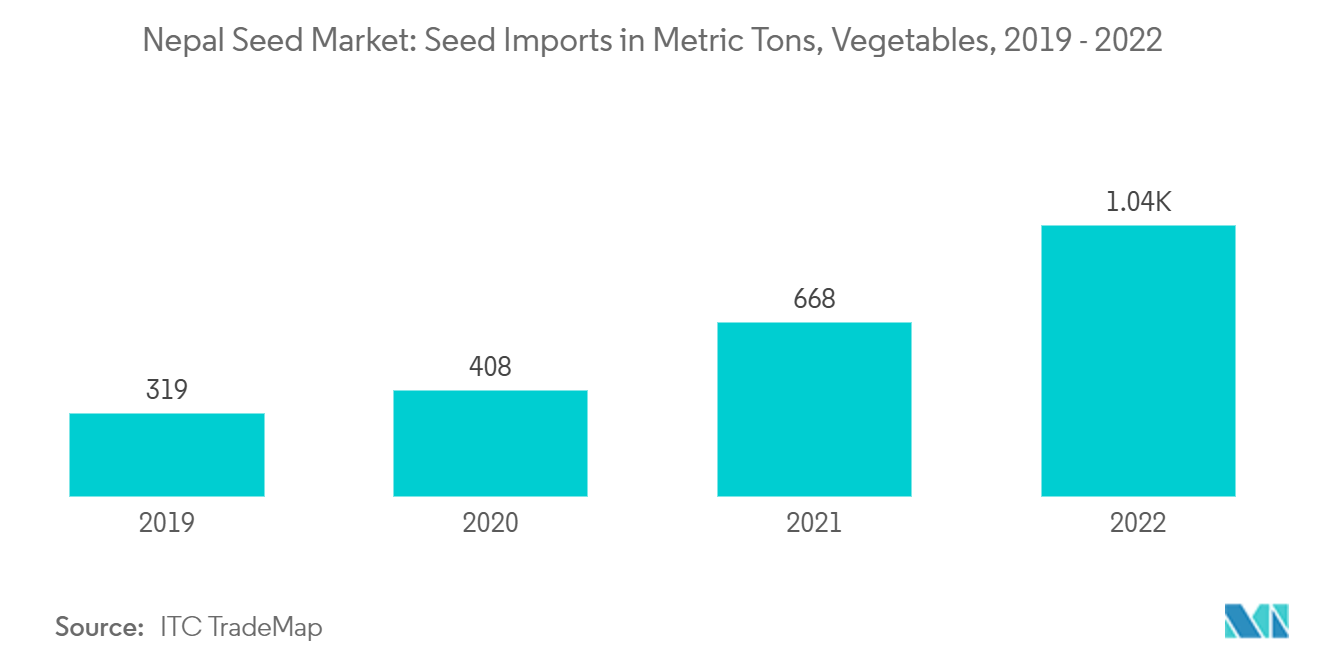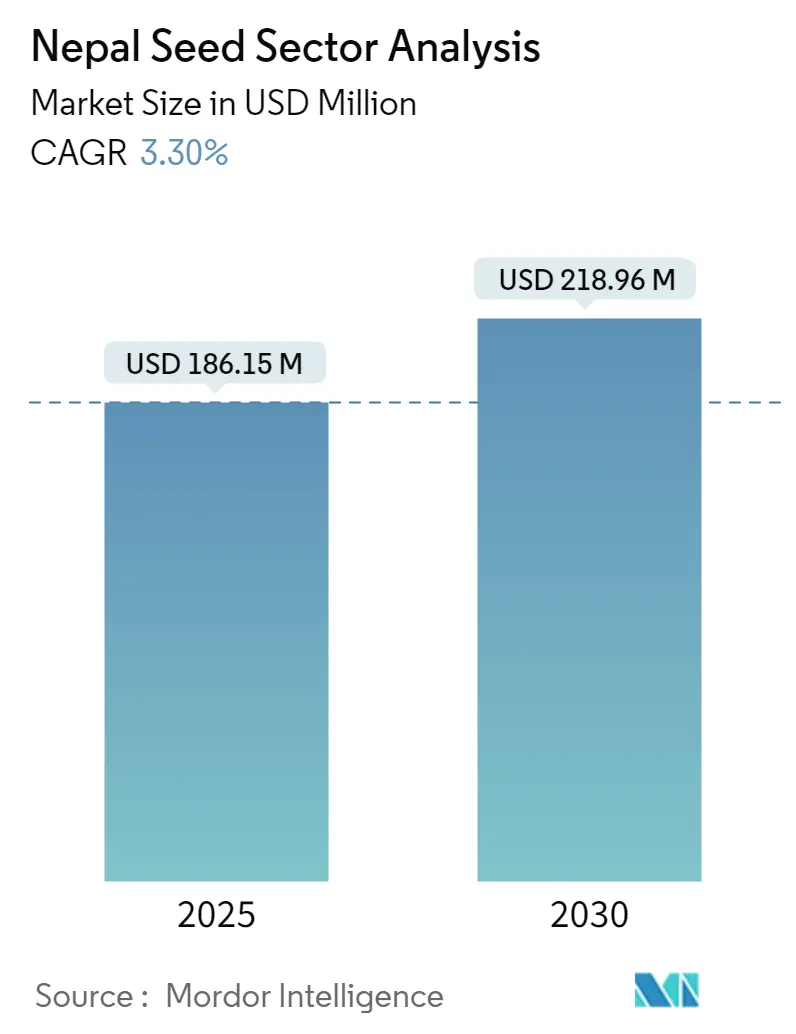
| Study Period | 2019 - 2030 |
| Base Year For Estimation | 2024 |
| Forecast Data Period | 2025 - 2030 |
| Market Size (2025) | USD 186.15 Million |
| Market Size (2030) | USD 218.96 Million |
| CAGR (2025 - 2030) | 3.30 % |
| Market Concentration | Medium |
Major Players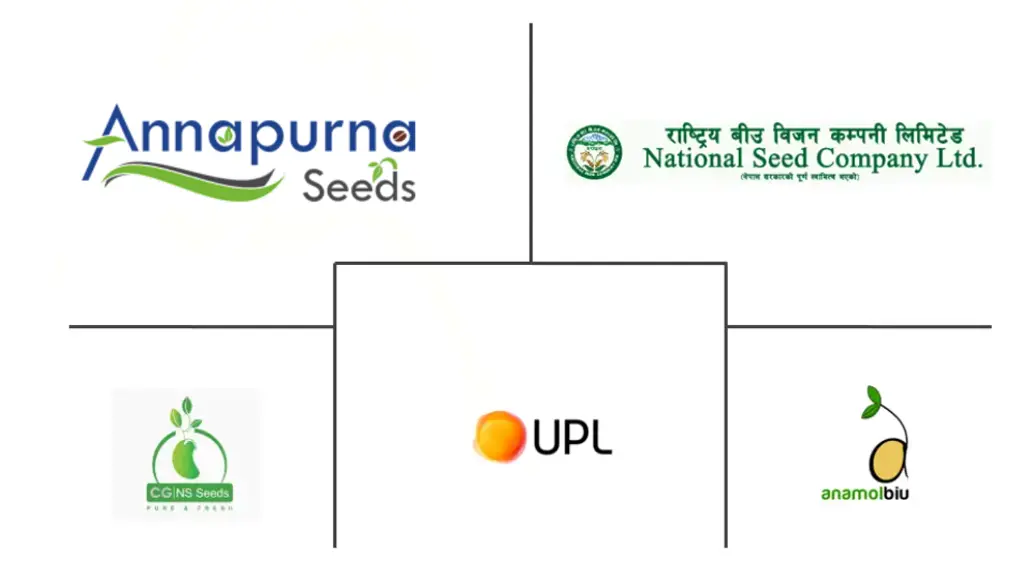
*Disclaimer: Major Players sorted in no particular order |
Nepal Seeds Market Analysis
The Nepal Seed Market size is estimated at USD 186.15 million in 2025, and is expected to reach USD 218.96 million by 2030, at a CAGR of 3.3% during the forecast period (2025-2030).
- Nepal's seed market plays a vital role in the country’s agricultural sector, which has been steadily evolving in recent years. With a growing population and increasing focus on food security, there is a stronger focus on enhancing seed quality and variety. Government initiatives aimed at improving seed production and distribution have been key drivers in the market’s development.
- In 2023, the government updated its agricultural subsidy scheme to a production-based system to promote the use of quality seeds. This policy aims to achieve self-sufficiency in seed supply, encouraging the private sector to invest in research to develop high-quality seeds. The government has allocated around USD 4.8 million (Rs 400 million) to support this initiative, providing a 50% subsidy on quality and high-yielding seeds purchased by farmers through local producers.
- Hybrid seeds have seen growing demand in Nepal due to their higher yield potential and resistance to pests and diseases. Government bodies like the Seed Quality Control Center ensure farmers have access to certified hybrid seeds. However, hybrid seed adoption is still in its early stages, for instance, in 2022, hybrid maize seeds only covered 10-15% of Nepal’s maize acreage, all of which relied on imports. This provides an opportunity for companies to increase their market share by offering quality and affordable seeds.
- The government collaborates with various stakeholders at national, provincial, and local levels to strengthen the country’s seed system. This includes disseminating technologies, building technical capacity, and reforming policies to maximize impact. For instance, the U.S. Agency for International Development (USAID) project targets seed testing and development at the federal level. These efforts are essential for creating a resilient and sustainable seed industry in Nepal.
Nepal Seeds Market Trends
Increase in Adoption of Hybrid Seeds
- The Nepalese seed market is experiencing increased adoption of hybrid seeds, driven by factors such as growing food security demands, changing climate conditions, and the need for higher crop yields. Hybrid seeds offer advantages including increased productivity, disease resistance, and improved quality. The country imports about 73% of vegetable seeds and over 60% of hybrid maize and rice seeds annually, primarily from India, China, Italy, and other countries.
- Hybrid varieties are gaining popularity among both commercial and small-scale farmers due to their desirable characteristics. The use of hybrid varieties in major vegetable crops such as cabbage, tomato, cauliflower, cucurbits, onion, and carrots is expanding annually, even in small farms of Nepal. An estimated 73% of vegetable production area in Nepal is covered by hybrid varieties. This trend is driving overall vegetable seed imports, with Nepal's vegetable seed imports increasing from 318 metric tons in 2019 to 1,038 metric tons in 2022.
- Nepal has implemented a ten-year Agriculture Development Strategy (ADS) and National Seed Vision (NSV) 2025. These initiatives emphasize various aspects of research and seed production to achieve self-sufficiency, explore market opportunities, and improve the country's economy. These efforts are projected to drive hybrid seed production during the forecast period.
- Nepal's adoption of hybrid seeds faces challenges like high costs, lack of awareness, and inadequate infrastructure. Addressing these issues requires government and private sector collaboration to promote quality seed use, support farmers financially, and invest in agricultural research. However, the government intiatives to enhance seed development and ability of hybrid seeds to increase the yield are the factors anticipated to drive the hybrid seed adoption during forecast period.
Growing Cultivation Areas Boost Seed Demand
- The agricultural sector is vital to Nepal's economy, with seeds being a crucial input for crop production. The expanding cultivation area in Nepal is a key driver for the seed market, directly correlating with the demand for high-quality seeds.
- According to the Food and Agriculture Organization, Nepal's total cultivated area has been steadily increasing. The total harvested area in the country grew from 4.4 million hectares in 2019 to 4.5 million hectares in 2022, representing an increase of about 1.6% during this period. This expansion of cultivated land is primarily driven by population growth, improved agricultural practices, and government initiatives promoting agricultural development.
- Cereals are the major crops grown in the country, with their cultivation area accounting for about 76.2% of the total cultivation area as of 2022. This extensive cultivation of cereals is projected to drive demand for cereal crop seeds during the forecast period.
- The increase in cultivation area has led to a surge in demand for seeds, particularly high-yielding and disease-resistant varieties. This has created opportunities for seed producers and distributors to meet the growing needs of farmers. Consequently, Nepal's seed market has expanded significantly in recent years, attracting an increasing number of domestic and international companies.
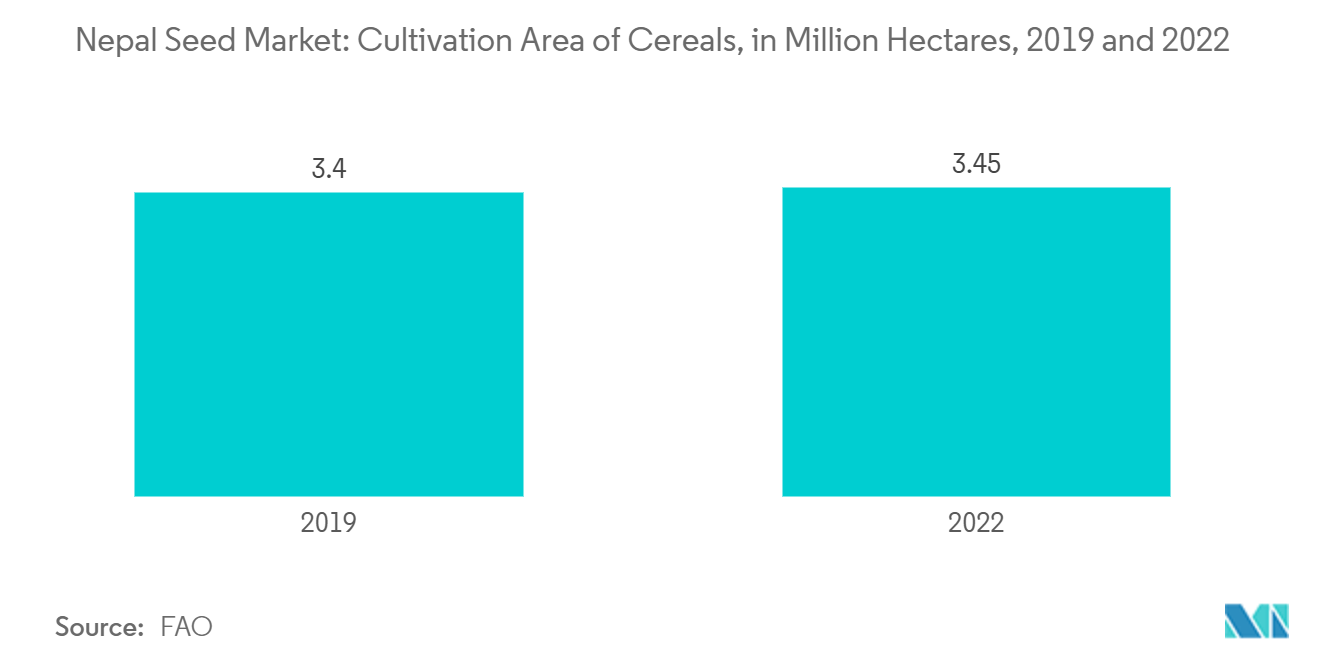
Nepal Seed Industry Overview
Nepal's seed market is fragmented, with public and private entities fulfilling distinct roles. The public sector predominantly focuses on cereal seed multiplication, while the private sector plays a crucial role in vegetable seed production. Key private sector companies include Anmolbiu Private Limited, UPL Limited, National Seed Vision Company Limited, CGNS Seeds Pvt. Ltd, and Annapurna Seeds. These firms employ various strategies to gain a competitive advantage, such as product innovation, partnerships, expansion and acquisitions.
Nepal Seeds Market Leaders
-
Anamolbiu Private Limited
-
UPL Limited (Advanta Seeds)
-
National Seed Vision Company Limited
-
CGNS Seeds Pvt. Ltd.
-
Annapurna Seeds
- *Disclaimer: Major Players sorted in no particular order
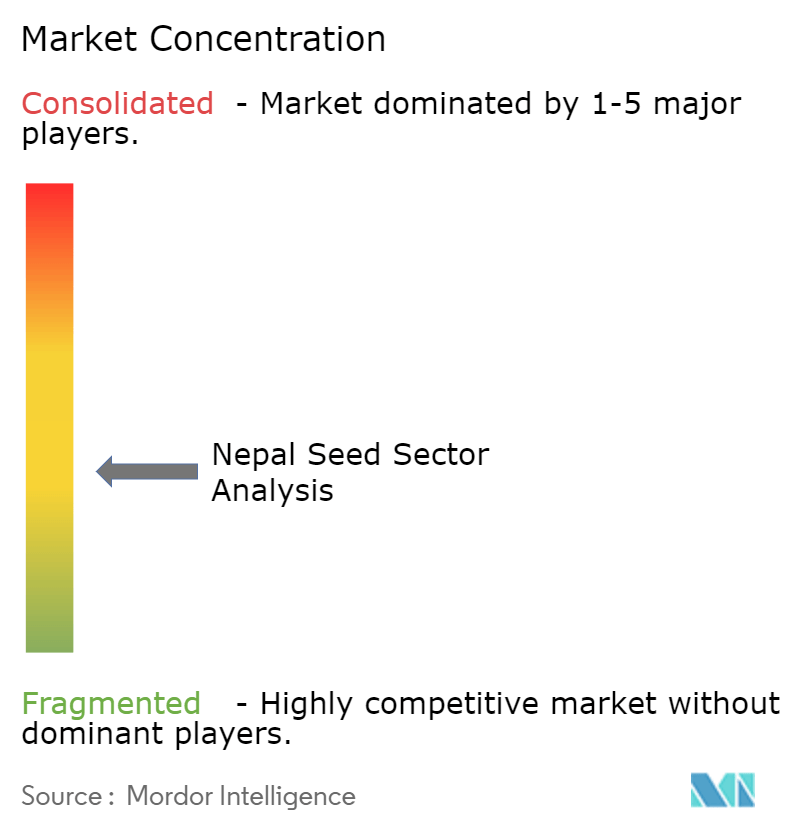
Nepal Seeds Market News
- August 2022: The National Seed Board of Nepal approved seven new rice varieties for cultivation, Ghaiya-3, Hardinath-4, Hardinath-5, Hardinath-6, Khumal Basmati-16, Ganga Sagar-1, and Ganga Sagar-3. These newly released cultivars possess multiple advantageous traits, including high grain production, superior grain quality, and resistance to pests and diseases. Some varieties also demonstrate flood and drought tolerance and a 20% higher nitrogen-use efficiency.
- February 2022: The Nepalese government has implemented a new seed policy allowing private seed companies to participate in the development, evaluation, and distribution of diverse seed varieties. This policy aims to boost domestic production of hybrid and non-hybrid seeds, enhance crop yields and food security, and promote a competitive seed industry.
Nepal Seeds Industry Segmentation
A seed is the ripened, fertilized ovule of a flowering plant containing an embryo capable of germination to produce a new plant. This report focuses on seeds for sowing at the farmer level, with market sizing conducted at this level. It segments the market based on crop type (Grains and Cereals, Pulses and Oilseeds, Cotton, Vegetables, and Other Crops), breeding technology (Hybrids and Open Pollinated Varieties & Hybrid Derivatives), and cultivation mechanism (Open Field and Protected Cultivation). The market volume is presented in metric tons, and the market value is expressed in USD.
| Crop Type | Grains and Cereals |
| Pulses and Oilseeds | |
| Cotton | |
| Vegetables | |
| Other Crops | |
| Breeding Technology | Hybrids |
| Open Pollinated Varieties & Hybrid Derivatives | |
| Cultivation Mechanism | Open Field |
| Protected Cultivation |
Nepal Seeds Market Research FAQs
How big is the Nepal Seed Market?
The Nepal Seed Market size is expected to reach USD 186.15 million in 2025 and grow at a CAGR of 3.30% to reach USD 218.96 million by 2030.
What is the current Nepal Seed Market size?
In 2025, the Nepal Seed Market size is expected to reach USD 186.15 million.
Who are the key players in Nepal Seed Market?
Anamolbiu Private Limited, UPL Limited (Advanta Seeds), National Seed Vision Company Limited, CGNS Seeds Pvt. Ltd. and Annapurna Seeds are the major companies operating in the Nepal Seed Market.
What years does this Nepal Seed Market cover, and what was the market size in 2024?
In 2024, the Nepal Seed Market size was estimated at USD 180.01 million. The report covers the Nepal Seed Market historical market size for years: 2019, 2020, 2021, 2022, 2023 and 2024. The report also forecasts the Nepal Seed Market size for years: 2025, 2026, 2027, 2028, 2029 and 2030.
Our Best Selling Reports
Nepal Seeds Industry Report
Statistics for the 2025 Nepal Seed Sector Analysis market share, size and revenue growth rate, created by Mordor Intelligence™ Industry Reports. Nepal Seed Sector Analysis analysis includes a market forecast outlook for 2025 to 2030 and historical overview. Get a sample of this industry analysis as a free report PDF download.



